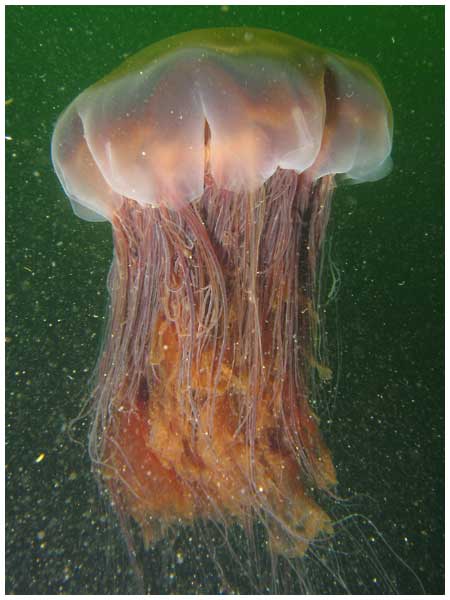But these jellyfish carcases are barely a hand wide. You'd never accidentally step on the body of stygiomedusa gigantea:
www.discoverynews.com For the first time ever, stygiomedusa gigantea, a gigantic jellyfish was caught on video by scientists in the Gulf of Mexico. Scientists say finding this massive species can provide better insight into habitat, behavior, and ecology of this mysterious creature.Wikipedia: http://en.wikipedia.org/wiki/Stygiomedusa_gigantea
Stygiomedusa gigantea is a species of giant deep sea jellyfish in the Ulmaridae family.
With only 114 sightings in the last 110 years it is a jellyfish that is rarely seen, but believed to be widespread throughout the world. It is thought to be one of the largest invertebrate predators in the deep sea ecosystem. The jellyfish has an umbrella-shaped bell that can be up to a metre wide, and has four arms that extend up to six metres in length. These "paddle-like" arms lack stinging tentacles, and scientists are unsure of their exact function. It has been suggested that they might be used to envelop and trap prey.
On May 19, 2009 scientists filmed a giant Stygiomedusa in its natural deep sea habitat for the first time. Direct observations of these creatures from submersibles are very rare. It has been previously videoed by scientists off the Pacific coast of the US and by ROVs off Japan. However, this is the first time the giant jelly has been recorded in the Gulf of Mexico.[1]
Video footage may be rare, but there are photos:
 |
| Monterey Bay Aquarium Research Institute |
 |
| from Ventnor Blog |
Fortunately for divers, this jelly is a simple creature. It "hunts" by way of running into food, ei any large object, attaches itself and waits for nutrition to happen. If not, it detaches and moves on. A bit like speed dating.
Another monster jelly is the Lion's Mane, capable of growing as long as a blue whale:
The lion's mane jellyfish (Cyanea capillata) is the largest known species of jellyfish. Its range is confined to cold, boreal waters of the Arctic, northern Atlantic, and northern Pacific Oceans, seldom found farther south than 42°N latitude. Similar jellyfish, which may be the same species, are known to inhabit seas near Australia and New Zealand. The largest recorded specimen found, washed up on the shore of Massachusetts Bay in 1870, had a bell (body) with a diameter of 7 feet 6 inches (2.29 m) and tentacles 120 feet (37 m) long.[1] Lion's mane jellyfish have been frequently observed below 42°N latitude for some time—specifically in the larger bays of the east coast of the United States.
These do sting, but they're not fatal to a healthy adult. Look, but don't touch!
Nemopilema nomurai , which looks a bit like a swimming mushroom, vies with Lion's Mane in size:
It's also an inadvertent sea hazard :
Giant jellyfish sink Japanese trawlerThey might sink your ship, but otherwise are indifferent to humans:
Powered by CDNN - Cyber Diver News Network
November 1, 2009
CHIBA, Japan — A 10-ton fishing boat has been sunk by gigantic jellyfish off eastern Japan.
The trawler, the Diasan Shinsho-maru, capsized off Chiba`as its three-man crew was trying to haul in a net containing dozens of huge Nomura's jellyfish.
Each of the jellyfish can weigh up to 200 kg and waters around Japan have been inundated with the creatures this year. Experts believe weather and water conditions in the breeding grounds, off the coast of China, have been ideal for the jellyfish in recent months.
The crew of the fishing boat was thrown into the sea when the vessel capsized, but the three men were rescued by another trawler, according to the Mainichi newspaper. The local Coast Guard office reported that the weather was clear and the sea was calm at the time of the accident.
It's literally another world down there.
And then there are the Immortals, Turritopsis nutricula:
http://en.wikipedia.org/wiki/Turritopsis_nutricula
Turritopsis nutricula, the immortal jellyfish, is a hydrozoan whose medusa, or jellyfish, form can revert to the polyp stage after becoming sexually mature. It is the only known case of a metazoan capable of reverting completely to a sexually immature, colonial stage after having reached sexual maturity as a solitary stage.[2][3] It does this through the cell development process of transdifferentiation. Cell transdifferentiation is when the jellyfish "alters the differentiated state of the cell and transforms it into a new cell". In this process the medusa of the immortal jellyfish is transformed into the polyps of a new polyp colony. First, the umbrella reverts itself and then the tentacles and mesoglea get resorbed. The reverted medusa then attaches itself to the substrate by the end that had been at the opposite end of the umbrella and starts giving rise to new polyps to form the new colony. Theoretically, this process can go on indefinitely, effectively rendering the jellyfish biologically immortal,[3][4] although in nature, most Turritopsis, like other medusae, are likely to succumb to predation or disease in the plankton stage, without reverting to the polyp form.[5] No single specimen has been observed for any extended period, so it is not currently possible to estimate the age of an individual, and so even if this species has the potential for immortality, there is no laboratory evidence of many generations surviving from any individual.
I don't know what they're waiting for. If I can't have flying cars, I'll settle for immortality.



